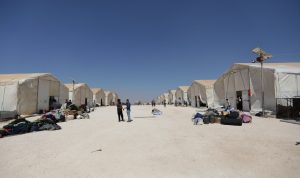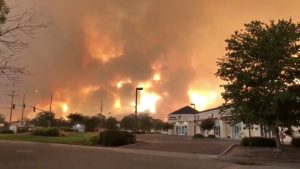
By Michelle Conlin
ESPARTO, California (Reuters) – The rental home seemed so beautiful when McKayla Ferreira first laid eyes on it. The roof had three gables, fruit trees grew in the backyard, and the front porch gleamed with a fresh coat of paint.
Then Ferreira moved in.
First, she noticed water leaking through the bathroom and kitchen ceilings. Then she found a furry black mold spreading across the walls and raw sewage sluicing through the crawl space. Worst, to her, were the black widow spiders swarming her kitchen cupboards and linen closets. “Those spiders were so big you could hear them,” Ferreira said. “They sounded like fingernails scraping a table.”
Ferreira called her landlord, Invitation Homes Inc, a creation of private equity giant Blackstone Group. The spiders were a “housekeeping issue,” the company representative told her, and she should “clean the place up.” Invitation Homes wasn’t enthusiastic about fixing the leaks, either. Two months passed before it sent someone to cut through the ceiling and fix the pipes, Ferreira said. Then the company took seven more months to patch it all up.
By the time the next tenants, Jennifer and Mike White, settled into the house on Craig Street, the spiders had been joined by colonies of roaches and ants, the couple said.

Whitney Hurst stands in front of the house that she rents from Invitation Homes in Esparto, California, U.S. April 24, 2018. REUTERS/Fred Greaves
After Whitney Hurst and her family moved into the property last year, Hurst said, she immediately called in a work order for a long list of complaints, including leaky pipes, vermin and a broken garage door that nearly fell on her children. She said the repairman who showed up to fix one of the leaks told her that he didn’t have the right wrench for the job and to “have your husband fix it.”
“I have given up calling them,” Hurst said, sitting in a lawn chair in her driveway, while her two boys, ages 3 and 9, played hide-and-seek inside. “I mean, there are spiders in my kids’ toys.”
An Invitation Homes spokeswoman acknowledged that the house had some problems when Ferreira rented it, including roof and plumbing leaks and “a spider issue.” The company said it compensated Ferreira $887.30 for maintenance and utility billing issues caused by the plumbing leak, plus two weeks’ rent. It said its records show that other issues with subsequent tenants have been “minimal” – termites and a problem with the heating and cooling system and that they were addressed.
Invitation Homes pitches itself as a singular landlord providing unprecedented ease and comfort for renters of its tens of thousands of single-family homes. But in interviews with scores of the company’s tenants in neighborhoods across the United States, the picture that emerges isn’t as much one of exceptional service as it is one of leaky pipes, vermin, toxic mold, nonfunctioning appliances and months-long waits for repairs.
Tenants also complain about excessive rent increases and fees that can add up to hundreds of dollars a year. In a proposed class-action lawsuit filed in May in the U.S. District Court for Northern California, renters accuse the company of “fee-stacking.” They allege that Invitation Homes charges tenants $95 if their rent is one minute late – even if the late payment is due to the company’s own nonfunctioning online payment portal – and then files an eviction notice to add more fees, penalties and legal costs if the tenant wants to stay in the home.
Invitation Homes filed a motion on July 20 to dismiss the case, saying the suit did not substantiate that the company’s fees were “unfair” and that the plaintiff lacked standing to assert the claims on behalf of tenants nationwide.
This is far from the alluring vision of life in a rental home that Invitation Homes has promoted since Blackstone, the world’s largest private equity firm, built the company on the wreckage of the foreclosure crisis.
As a Blackstone vehicle, Invitation Homes led Wall Street’s charge into the single-family-home rental business, snapping up houses at fire-sale prices. After its merger, last November with Starwood Waypoint Homes, another private-equity-backed foray into the market, Invitation Homes became the largest landlord of single-family homes in the United States by the number of rental units.
Today, Invitation Homes manages 82,000 properties, most of them entry-level three- and four-bedroom houses in 17 metropolitan areas concentrated in the Sun Belt. Its portfolio – though still less than one percent of the overall single-family rental market – is 58 percent larger than that of its nearest competitor, American Homes 4 Rent.
PROMOTING THE GOOD LIFE
With its vast resources, Dallas, Texas-based Invitation Homes boasts that it has revolutionized the business of managing single-family rental homes and the experience of living in them. In a traditionally fusty mom-and-pop business, it says in marketing materials, it has created a uniquely “worry free” living environment that promises “peace of mind” with “exceptional resident services,” including “24/7 emergency maintenance.”
Chief Operating Officer Charles Young disputed tenant allegations of slumlord-like behavior. He noted that Invitation Homes serves hundreds of thousands of customers a year and that in internal company surveys, those tenants give the company 4.32 out of 5 stars. “From time to time, things happen,” Young said in an interview. “But when there’s an issue, we work hard to resolve it as quickly as we can.”
Affordable-housing advocates, real estate professionals and other critics of Wall Street’s push into the rental market say the tenant complaints suggest that rapid growth has stretched Invitation Homes’ ability to manage its properties. They also assert that there’s a deeper problem: Invitation Homes, like some of its Wall Street-backed peers, adheres to a business model that pressures it to lean hard on tenants to satisfy investors.
These companies have financed their growth by selling billions of dollars in bonds – the rental-market equivalent of the mortgage-backed securities that led to the financial crisis – to pension funds and other big institutions. Industry critics say that to keep payments to bond investors rolling, companies like Invitation Homes must minimize maintenance costs and maximize rents and fees.
“We see securitization of rental income as highly problematic,” said Kevin Stein, deputy director of the California Reinvestment Coalition, a nonprofit that advocates for affordable housing. Among other things, he said, it “pits Wall Street investors against Invitation tenants.”
Among those tenants is Contrell Wethersby in Atlanta, who told Reuters she had to go for more than a year without heat or a functioning refrigerator, stove, microwave or garage door – not to mention having to endure a leaky ceiling and black mold.
Invitation Homes said it is committed to operating in accordance with all federal, state and local housing laws. It said its records showed that Wethersby’s issues did not persist for any significant length of time and that work crews had trouble scheduling with her. The company did not provide its records for Wethersby or any other tenants.
Some renters, like Willie Jean Brister in Los Angeles, have seen their rent increase by as much as 50 percent over three years. During that time, Brister has filed work orders for an exterminator and repairs on a bathtub, faucets, bathroom door, cabinet doors, fence, hot water and garbage disposal – all of them reviewed by Reuters on the company’s web portal. The grandmother with five children in the house said the portal keeps saying “ ‘work completed,’ but the work is never completed. You get worn out, like you are paying all this rent and not getting any services.”
Others, like Heather Tolaro, said they and their children became ill from toxic mold in their houses. Tolaro sued Invitation Homes in federal court in Illinois, alleging that the company refused to acknowledge or fix the problem. The case was settled for undisclosed terms.
Rosa D’Amico said that after one heavy rain, she watched as water poured into her Chicago rental home, destroying much of her personal property. The house, stinking of sewage, was uninhabitable. Invitation Homes eventually agreed for D’Amico and her family to move to a different house, but she said she had to pay the $1,800 bill for the move. Then that house flooded.
“It was poop water, sewer water, so I had to throw everything out,” D’Amico said. “And they never paid me a penny.” She now lives in a rental nearby.
The company said it was pleased to continue to serve the Bristers. It said its records show that all the repairs Brister had requested were made, to which Brister responded: “They patch things, they don’t fix things.”
It declined to comment on Tolaro’s case, citing the confidential settlement. As for D’Amico, Invitation Homes confirmed that the first house “suffered water damage.” It described the problem with the second house as an “odor” resulting from dry traps in the sink, floor and laundry drains, all of which were “serviced.”
Invitation Homes went public in February 2017. Blackstone still owns a 42 percent stake, valued at $5.1 billion. Blackstone is now in the process of buying a majority stake in the financial-services division of Thomson Reuters Corp, owner of Reuters News, in a deal valued at $20 billion. The transaction is expected to close in late summer. Blackstone and its chief executive officer, Stephen Schwarzman, declined to comment for this article.
NO OTHER CHOICE
In the interview, Invitation Homes COO Young said that rather than putting the squeeze on renters, the company’s business model gives families the “optionality and freedom” to live in the kinds of good homes in good school districts near good jobs that they may not be able to afford to buy. “We are providing a housing option that didn’t exist before,” he said.
He rejected assertions that the company skimps on repairs and maintenance to support payouts to investors. “In the consumer business, we know things are not always spot on,” he said. “We ultimately are trying to do the right thing by our communities and for our residents to provide the service we can live up to.”
Young also reiterated the company’s assertion that its investments in renovations and property upkeep have helped foreclosure-ravaged neighborhoods recover, and that 70 percent of its tenants renew their leases.
At Reuters’ request, the company provided the names of five satisfied renters. Two responded, saying they were pleased with the company. One of them, Melissa Grant of Atlanta, said Invitation Homes was an “awesome company” for, among other things, making homes “available to families like me who are in the military and need to move around a lot.” The other three tenants did not respond to repeated phone messages.
Some tenants told Reuters they renewed not because they loved their rentals, but because they felt they had to: The company owns so much of the available housing in their neighborhoods that they had no alternatives if they wanted to keep their kids in the same school, or remain close to jobs or relatives. And moving itself is a big expense.
“You can’t just jump up and move with children,” Brister said.
While Invitation Homes’ portfolio represents less than one percent of single-family rental homes nationwide, the figure can be much higher in markets where the company’s inventory is concentrated. In some neighborhoods in California, for example, Invitation Homes owns as much as 25 percent of single-family rentals, according to an analysis of Census and property data by Maya Abood, a former researcher with the Massachusetts Institute of Technology’s Urban Planning Program who co-authored a recent study titled “Wall Street Landlords Turn American Dream into American Nightmare.”
Invitation Homes has been raising rents by as much as an average of 10 percent a year in places like Oakland, California – nearly double the norm in that market – according to the Alliance of Californians for Community Empowerment (ACCE), an advocacy group. At the same time, the company has been adding to the types of fees it charges tenants – not just for late payments, but for things like rent paid on debit cards, which incurs a $30 charge.
Fees have helped lift earnings by 20 to 30 percent a year. In a recent earnings call, the company attributed rising profits in part to its “system” to “track resident delinquency on a daily basis.” This system allows the company to start charging fees and penalties the minute a tenant fails to pay on time.
The company’s stock price has risen about 11 percent since last year’s initial public offering. Wall Street analysts have almost uniformly rated the stock a “buy.”
Analysts’ optimism reflects, in part, that while scores of federal, state and local rules protect homebuyers when taking out a mortgage and renters in multi-unit apartment buildings, few protections exist for tenants of single-family homes, housing lawyers and affordable-housing advocates said.
“Allowing hedge funds and private equity firms to speculate on housing with little-to-no public oversight or regulation puts families at greater risk of unfair rent increases and evictions, and threatens the right to housing itself,” Abood said.
A December 2016 Federal Reserve Bank of Atlanta analysis found that Wall Street landlords are far more likely to file eviction notices than mom-and-pop landlords. It said Colony Starwood – as Starwood Waypoint was known until shortly before the merger with Invitation Homes – filed eviction notices on more than 30 percent of tenants, while Invitation Homes filed notices on nearly 15 percent. The strongest predictor of whether a tenant would get an eviction notice was if the tenant was African-American, the Atlanta Fed said.
The analysis didn’t specify which companies were responsible for the eviction notices disproportionately filed on African-Americans. Invitation Homes said it treats all residents equally. The company spokesperson noted that an eviction notice is a “procedural step” in a landlord’s effort to collect rent, and that “the vast majority of those who received eviction notices ultimately were resolved without the resident being put out of their home.”
In California, groups of Invitation Homes tenants, organized by ACCE, have stormed the offices of Blackstone three times to demand an end to what they say are the business’s worst practices, such as forgoing repairs and hiking rents.
Last October, more than three dozen renters of homes across Los Angeles burst through the front door of Blackstone’s headquarters in Santa Monica, shaking noisemakers, honking sirens and chanting through megaphones: “Hey, Blackstone, shame on you,” “Slumlord,” and, “You being evicted, Blackstone!”
Blackstone executives rushed out of the building through the emergency exits and the back door.
On office desks, the tenants left letters addressed to Blackstone CEO Schwarzman, asking for a moratorium on rent increases, an end to “outrageous fees,” proper maintenance on homes and a meeting with Blackstone executives.
After 20 minutes, security personnel threw them out.
An Invitation Homes spokesperson said the company got back to all the renters about their complaints.
Lupita Gonzalez, the ACCE organizer, said: “We never heard anything. We never heard back.” Reuters was able to contact four of the renters who participated in the October protest, all of whom said they never heard from the company.
KEEPING INVESTORS HAPPY
The business of being landlord of a single-family home was for years a small, local affair. But after the 2008 financial crisis, Wall Street saw an opportunity: Buy houses in bulk in “strike zones,” industry parlance for high foreclosure neighborhoods with good schools, well-maintained transportation systems and healthy job growth.
Then the firms could rent the properties to the kinds of families that would normally buy – householders who are on average 39 years old with young children and an average income of $100,000 or more. Today, nine big Wall Street firms collectively own more than 200,000 single-family homes in 13 states.
Invitation Homes says it spent an average of $200,000 per house to build its portfolio, and $22,000 each on renovations and repairs. To pay for all of that, it pioneered a new asset class, so-called single-family rental securities, or SFRs. Since 2013, Wall Street landlords have sold more than $15 billion of the bonds. As supply has tightened and prices risen in real estate markets, Invitation Homes has slowed expansion of its portfolio. Now, it largely rolls over existing bonds, paying investors out of rent and fees from tenants.
In September, the government-sponsored entity Fannie Mae lent its blessing to this new market, guaranteeing the refinancing on a $1 billion Invitation Homes rental-backed bond.
That imprimatur prompted more than 25 groups – affordable-housing advocates like the Community Home Lenders Association and rival business groups such as the National Association of Realtors – to complain to Fannie Mae’s overseer, the Federal Housing Finance Authority (FHFA), that the deal strayed from Fannie Mae’s stated mission of supporting home ownership. Invitation Homes’ business model, they said, risked pushing up rents and reducing the inventory of affordable homes.
Corinne Russell, spokesperson for the FHFA, said the agency had authorized such transactions to help Fannie Mae and its sibling agency, Freddie Mac, “understand the challenges and opportunities in the single-family rental market … and help FHFA assess what role, if any, the Enterprises should play in this market going forward.”
A spokesman for Fannie Mae said: “This transaction is a great opportunity to continue to serve the growing single-family rental market. Invitation Homes is a strong partner with deep experience managing a large volume of single-family rental properties.”
Just as Fannie Mae was lending its federally backed support to one of Invitation Homes’ bonds, regulators began looking into the securities.
At issue are the home valuations Invitation Homes relied on for its bonds. The higher the valuation, the higher the expected rent, and thus the more investors are willing to pay for the bonds.
To get a mortgage, homebuyers typically must have a licensed inspector conduct an appraisal of the house. To price its bonds, however, Invitation Homes relied on so-called broker price opinions, or BPOs. These less-expensive alternatives were provided mostly by outside firms using independent contractors who were not licensed appraisers.
Many of these contractors relied only on exterior views of the houses – no interior inspections – according to regulatory filings. The filings also indicate that the contractors were told to assume that the interiors had been remodeled to the standards advertised on the Invitation Homes website. Congress outlawed BPOs after the foreclosure crisis, but the ban doesn’t apply to institutional investors buying homes in bulk.
In September, Invitation Homes disclosed in a regulatory filing that it had received a subpoena from the Securities and Exchange Commission requesting documents and communications related to its securitizations. In its accompanying letter to Invitation Homes, the SEC said it was looking at the valuations the company relied on to price its bonds.
The SEC would not comment on the investigation, nor would Invitation Homes. In its regulatory filing, the company said: “The SEC letter indicates that its investigation is a fact-finding inquiry and does not mean that the SEC has a negative opinion of any person or security. We are cooperating with the SEC.”
A look inside the bond that Fannie Mae backed shows how Invitation Homes’ model is working. From each of the 7,204 houses bundled into the bond, the Fannie Mae prospectus shows, the company earned in 2016 an average monthly rent of $1,538 and $985 in annual “other income,” defined as fees for, among other things, “pets or cleaning.”
At the same time, the company spent an average of $1,142 a year on repairs, maintenance and turnover costs, based on the bond data. That’s less than the $3,100 a year Americans tend to spend on maintenance, repairs and improvements on houses of the same age as Invitation Homes’ portfolio, according to an analysis of the U.S. Census Bureau’s American Housing Survey by BTIG equity analyst Ryan Gilbert.
The company said the $1,142 figure is “not representative” because it doesn’t include the $750 the company reserves per home for capital expenditures should the property need a “major system replacement.”
Five former employees said Invitation Homes routinely didn’t spend enough on repairs or hire enough contractors to get the job done. One former maintenance contractor said that he oversaw 2,000 homes scattered across one metropolis and that he couldn’t possibly keep up.
On a recent tour the company provided for Reuters in Atlanta, executives walked through a newly renovated four-bedroom house in a development called Legacy Court, where tenants have access to tennis courts, a pool, pocket parks and a community center.
The executives led Reuters on what they said was their standard walk-through prior to every rental, entailing inspection of 250 items. A maintenance manager checked every knob, outlet, spout, latch, doorstop, lightbulb, blind and appliance. He ran the dishwasher, filled the tub and tested the garbage disposal. “We test, touch and feel everything, fixture by fixture, before renting out the house,” he said.
STILL RENTING
Income from the house with the black widow spiders on Craig Street in Esparto, California, is in the Fannie Mae-backed bond.
The house had been owned by the same couple for nearly 10 years before they lost it to foreclosure in 2012. For five months, the house sat empty. Then, in September 2012, property records show, Fannie Mae sold it to Blackstone for $173,000.
The following year, McKayla Ferreira moved in. Around the time she began noticing the spiders and the sewage, Blackstone was packaging the house’s rental income into one of its bonds.
Though the Fannie Mae bond does not break out address-level data, Reuters was able to identify the Craig Street house by cross-referencing the bond’s data with local property records, sales documents and other information.
The bond notes that Invitation Homes spent $370 in 2016 on maintenance and repairs for the Craig Street house. The company said costs associated with the house should also include lease turnover expenses – what a landlord spends to prepare a house for a new renter – which added $2,703 to 2016 expenses.
Ferreira said she paid her rent on time, but Invitation Homes often claimed it never received the money and staple-gunned eviction notices to her front door. It insisted she pay a 10 percent late fee, plus other penalties, on her $1,300-a-month rent – or lose her lease. Ferreira would send canceled checks to the company, only to watch the same scenario unfold the following month.
Invitation Homes acknowledged that when Ferreira was a tenant, the company was “in its infancy” and that some billing and receivables systems had “yet to be refined.” The company also said it reversed the charges and had established additional processes “to help prevent this from occurring in the future.”
Two subsequent renters said some billing errors continued. Invitation Homes said its records show no such issues.
All three families had hoped to save money while living on Craig Street for a down payment to buy a home. All said that fees and unexpected expenses ate into those savings.
Whitney Hurst and her family are still renting the house on Craig Street. The two previous tenants are renting from other landlords.
(Edited by John Blanton)
















